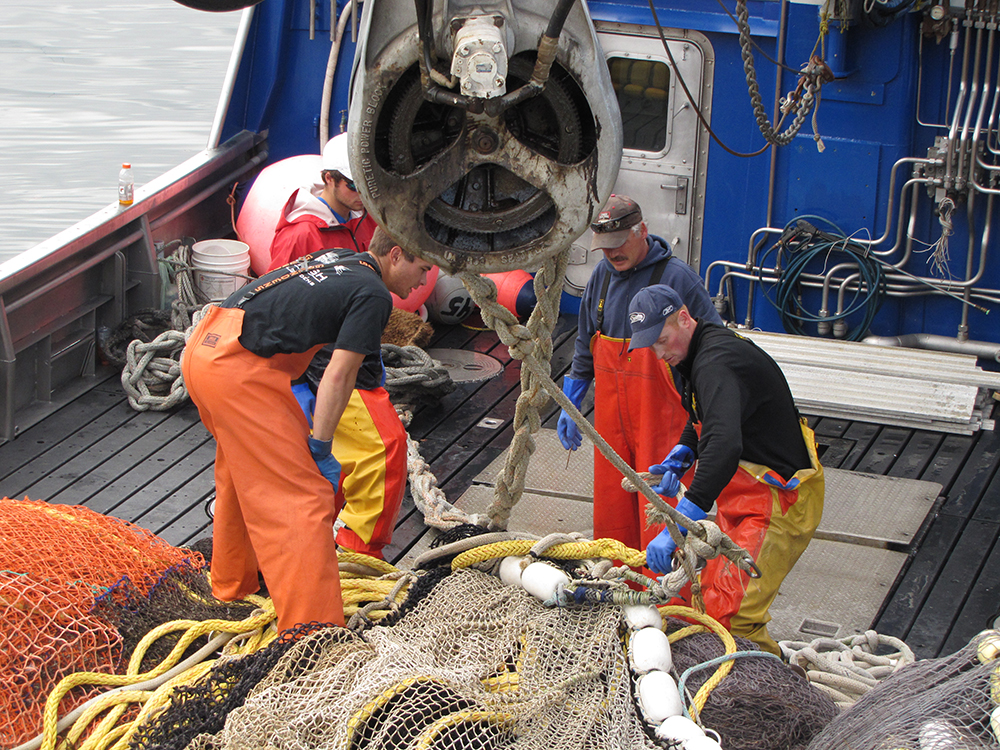
To say that fishing is a tough job is an understatement. The long hours. The physical strain. The mental focus. Add rough weather and shorter fishing seasons to the mix and the work not only gets tougher for the commercial angler, but it can sometimes lead to injury.
Richard Ogg, a longtime fisherman from Bodega Bay, Calif., can remember fishing 12 days straight and operating on a few hours of sleep each night. But the volume of product and the amount of money to be made was significant.
“Your whole yearly income can be made in a matter of a few weeks or a month in the season, so that pressure to get things done—you just make it happen,” Ogg said. “The potential for injury is significant because you’re pushing so hard and you’re trying to do everything you can to make ends meet as quickly as possible because you may not be able to go out again for a week or a month. You just don’t know.”
Oregon State University’s Fishermen Led Injury Prevention Program, or FLIPP, surveyed 426 fishermen, most of them crabbers, to ask them what mostly contributes to commercial fishing injuries. The answers varied, from “lack of focus” and “lack of practice or drills” to “rough sea” conditions and “being in lousy physical shape.”
The job puts physical and mental stress on any angler, and staying physically, mentally and spiritually fit is key to staying healthy and safe on the water.
Dave Bitts, a McKinleyville, Calif. fisherman who’s been fishing salmon and crab since the 1970s, said dexterity matters in handling gear, pulling fish and cleaning fish.
“I’d rather catch two 15-pound fish than one 30-pound (fish),” he said. “The bigger fish can hurt me every time I handle him.”
He also took pains to set up the back deck, so he doesn’t have to bend over to work the gurdies. Technique also matters, Bitts added.
“One year my wrist started hurting midseason,” he remarked. “I realized my landing technique was putting unnecessary strain on my wrist.”
Both salmon and crab fisheries require constant alertness and paying attention to what’s happening in the ocean. Watch for current, color and temperature changes, rips, birds or whales feeding and the behavior of your fellow fisherman, Bitts said.
“How deep are these fish? (I) don’t want my gear too shallow or too deep,” Bitts said. “Sometimes bottom structure, like rock, piles or canyon edges, is the crucial factor. All this, while paying attention to your radios.”
Communicating with fellow crew members and being prepared to work are important, especially when it comes to fishing for crab, Ogg said. He added that assembling a good team of crew members also helps to prevent injury and keep everyone safe.
“My crew ends up spending 10 days putting gear together, making sure it’s perfect, making sure everything’s ready to go, so when the bell sounds, we’re ready to run,” he said.
What one does when not fishing also matters.
Linda Behnken, executive director of the Alaska Longline Fishermen’s Association, suggests staying active in the offseason.
“Hike, run, ski, lift weights, stretch regularly,” she said. “Drink lots of water. Eat healthy food.”
She suggested making pre-cooked meals and freezing them to have healthy food ready to go. To stay mentally sharp, Behnken also suggested listening to audio books. Anglers should stay active on the job too.
“Move! Don’t sit still at the wheel!” Behnken said. “Shift jobs on the boat.”
There are also a number of organizations that offer programs and classes that help anglers stay fit, such as the National Institute for Occupational Safety and Health (NIOSH).
The Alaska Longline Fishermen’s Association hosts expos in the spring and fall that incorporate health and well-being. The most recent, a one-day event that took place in November, featured a lineup that included “Take 5: Five Take-Home Messages to Prevent Injuries.”
The Alaska Marine Safety Education Association (AMSEA) is also involved in a number of projects dedicated to the health and well-being of anglers. AMSEA is helping Oregon State’s FLIPP find and share best first-aid training approaches, as well as creating region-specific aids for training and providing other support for the NIOSH and the U.S. Coast Guard-funded effort.
FLIPP, which aims to understand and help prevent injuries among anglers in the Dungeness crab fleet, also collaborated with fishermen on tips to lower injury risks. For example, it includes a one-pager on how a bang bar can reduce risks to deckhands and a study that measures the stability, posture and muscle statistics of 25 deckhands harvesting crab.
Lastly, having a passion for catching fish is essential, Ogg said.
“You’ve got to love what you’re doing, because it could be horrible at times, but when it’s good, it’s really good, and there’s just nothing like it,” Ogg said. “I mean, I wouldn’t trade it for the world.”
KAREN ROBES MEEKS, a Southern California native, is an award-winning journalist with more than 20 years’ writing experience. Her articles have appeared in the Los Angeles Times, San Francisco Chronicle, Orange County Register and Long Beach Press-Telegram, where she worked as a reporter for nearly 14 years. Her work has been recognized by the California News Publishers Association, the Associated Press News Executives Council and the Los Angeles Press Club.
